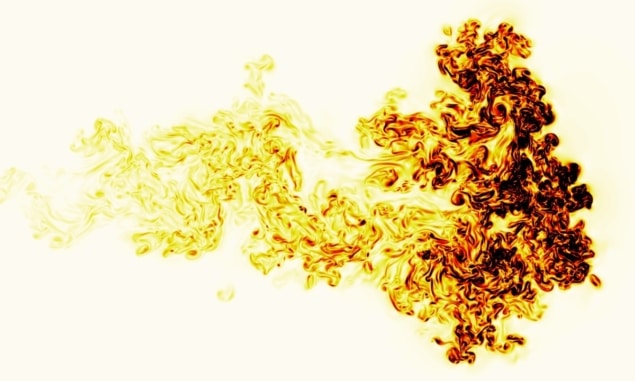
When the temperature drops, turbulent puffs caused by coughs and sneezes become more buoyant and travel further and last longer, scientists in Japan and Italy have discovered. The researchers say the results of their modelling study could help improve our understanding of the airborne transmission of viruses like SARS-CoV-2.
A turbulent puff occurs when a mass of fluid is ejected from a localized source. In an undisturbed environment, the cloud of fluid – the puff – moves freely and evolves over time. Puffs are important in environmental and health sciences, chemistry, and other fields. How they travel and change over time has implications for the dispersal of pollutants, such as those from chimneys, and the transmission of disease droplets in coughs, for example.
Despite their importance, current theory on puff dynamics is based on work conducted almost 50 years ago, in the 1970s. But that work only focuses on the large-scale dynamics of the puff, such as how fast it moves and its size. It provides scaling laws that explain how a puff increases in size and slows down over time. It does not, however, consider the small-scale dynamics of the turbulent fluctuations inside the puff, and our understanding of these remains elusive.
Complex characteristics
Turbulence in puffs has more complex characteristics than turbulence in continuous ejections of gas or liquid, making it more challenging to study, explains Marco Rosti, an expert in fluid dynamics at the Okinawa Institute of Science and Technology Graduate University in Japan. “But it’s of vital importance – especially right now for understanding airborne transmission of viruses like SARS-CoV-2,” he adds.
To fill in the gaps in the previous theory, Rosti and Andrea Mazzino, a physicist at the University of Genoa in Italy, developed a mathematical model that includes the small-scale structure of turbulence fluctuations in a puff. Their model looked at how both the small-scale and large-scale dynamics of a puff change over time, and how this is affected by temperature, humidity and velocity fluctuations. The researchers used a supercomputer to verify their models against state-of-the-art numerical simulations that could resolve the behaviour of puffs at the large-scale and the small-scale run. They report their results in Physical Review Letters.
Rosti and Mazzino initially found that their results fitted with the previous model of puff dynamics, with turbulence in the puff dictating how it behaved. Over time the puffs expanded and slowed down in a predictable way that was linked to their initial speed, size (radius) and fluid density. But they discovered that if the environment cooled these scaling laws changed, as the temperature difference between the warm puff and the cooler ambient air increased.
Buoyancy matters
At cooler temperatures buoyancy starts to play a role in puff dynamics, their results show. The gas or liquid in the puff is significantly warmer and therefore less dense than the environment. Because of this the puffs rise higher, last longer and travel further. “The effect of buoyancy was initially very unexpected. It’s a completely new addition to the theory of turbulent puffs,” says Rosti.
These findings could improve our understanding and modelling of the airborne transmission of viruses and how it changes with environmental conditions. The researchers write that they expect their results to have “a profound impact on developing evaporation models for virus-containing droplets carried by a turbulent puff, with benefits to the comprehension of the airborne route of virus contagion”.

Air purifiers could spread viruses in confined spaces
“How fast the droplets evaporate – and therefore how small they are – depends on turbulence, which in turn is affected by the humidity and temperature of the surroundings,” explains Rosti. “We can now start to take these differences in environmental conditions, and how they affect turbulence, into consideration when studying airborne viral transmission.”
Rosti and Mazzino now plan to study how puffs behave when made of more complex non-Newtonian fluids. “For COVID, this could be useful for studying sneezes, where non-Newtonian fluids like saliva and mucus are forcefully expelled,” explains Rosti.



